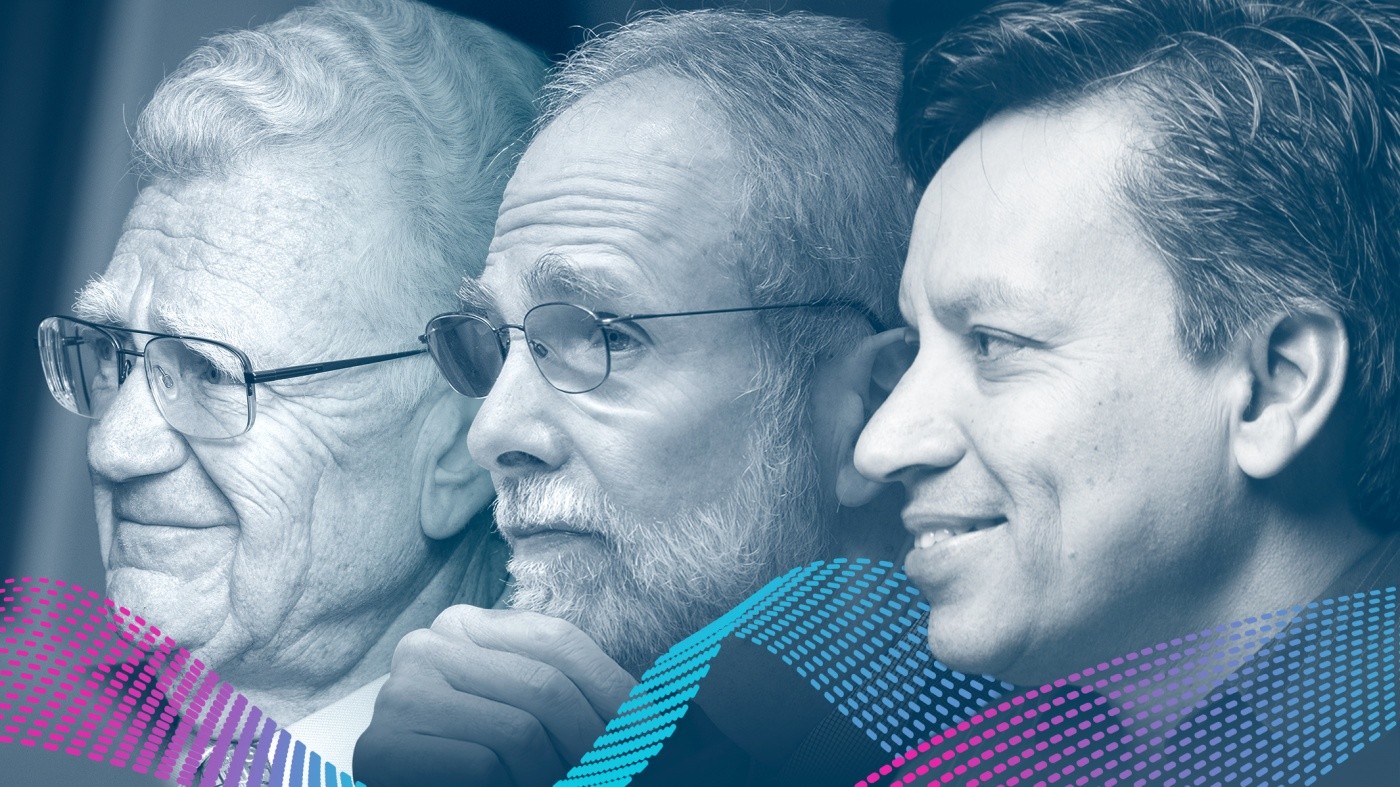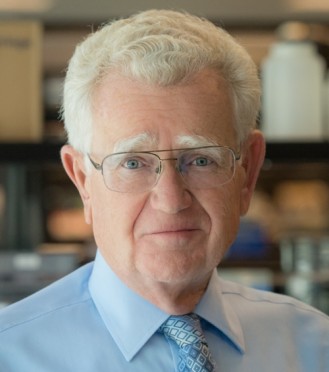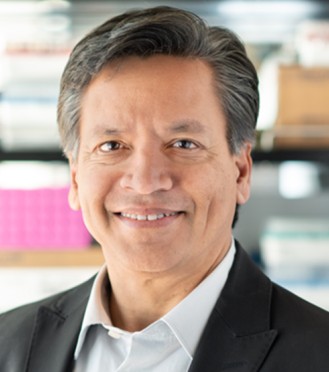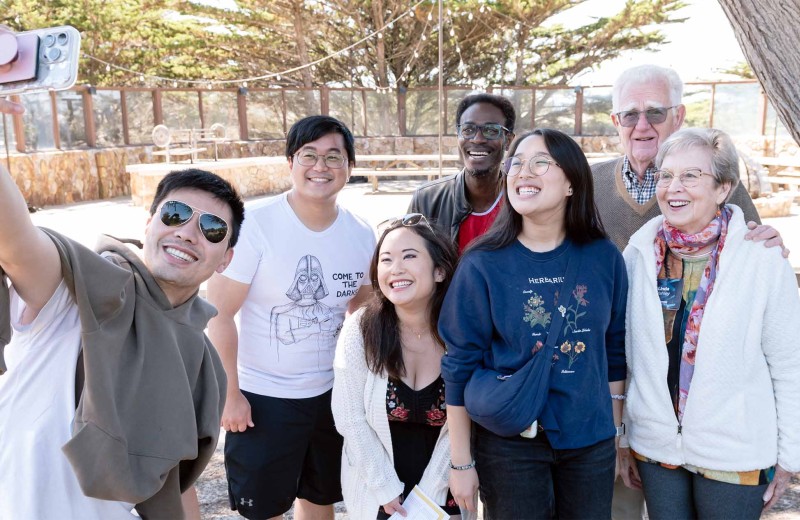Gladstone NOW: The Campaign Join Us on the Journey✕

Robert Mahley and Sandy Williams each helped define distinct eras in Gladstone’s evolution—and conversely, the times during which they served defined how they would lead. Now, Deepak Srivastava is paving the way for the organization's future.
You can forgive Robert Mahley if he sounds a little bit like a quixotic trail boss from the Old West, reflecting on what it was like 40 years ago when he came to San Francisco to launch the Gladstone Institutes as its founding president. Here was a 37-year-old cardiovascular scientist, perfectly content running a small lab at the National Institutes of Health (NIH), making important discoveries in their atherosclerosis research, plunging into a new frontier, and bringing others along for the ride.
Let’s back up a little bit first. In 1971, J. David Gladstone, a pioneering shopping center developer in California died suddenly, leaving behind an estate valued at $8 million, which he intended to support medical students also interested in research. But it soon became clear to the three trustees administering the trust—Richard Brawerman, Richard Jones, and David Orgell—that there was far more that could be done. So in 1979 they created the J. David Gladstone Institutes, a new kind of biomedical research center.
The thing is, the trustees were two lawyers and a silver and porcelain merchant, not a scientist in the bunch—they needed someone to lead this new enterprise, and Mahley was their man.
But there was no building at the time—no structure, no administration, no policies, no procedures. There was only the trustees’ vision, and that’s what captured Mahley’s attention, sparked his imagination, and brought he and his entire lab in 1979 from their well-established, protective NIH comfort zone, to the West Coast, where they faced an unknown but hopeful future.
That future has panned out into something bigger and better than the founders, including Mahley, could have imagined. But it doesn’t change the fact that Mahley’s first response to the trustees’ invitation to lead this journey was a polite but firm, “no thank you. My work was going well. My wife, Linda, and I enjoyed living in Maryland,” says Mahley, MD, PhD. “I said no and hung up.”
Fortunately, Mahley received a second call and was invited to come to San Francisco with his family for a few days. So, the family went, Mahley met the trustees and changed his mind, foreseeing a blueprint for the rest of his life.
“They had a tremendous vision,” he says. “They wanted to do something new and they wanted to do something different. What sold me on Gladstone was the trustees.”
Particularly Jones, who during one discussion put his hand on Mahley’s shoulder and said, “Bob, we’ll do right by you and the others.”
Those were magic words to Mahley’s ears, who took them to mean, “Here is an opportunity, and we don’t know how it’s going to go, but we will do right by you and those you bring along,” he says. “And forever I’ll be grateful to the fact that essentially everybody from my lab at the NIH was willing to move clear across the country with almost nothing more than a wish and a promise that something good would happen.”
So, with Mahley at the helm, seven families moved to San Francisco to lay the foundation of the Gladstone Institutes, and Mahley established a culture of leadership that his successors have embraced and built upon, leaving their own marks on the institution and the president’s office.
“Bob Mahley, as the founder of Gladstone, is really the one who built the philosophy around our organization,” says Deepak Srivastava, MD, who became the third president of the Gladstone Institutes in January 2018. “He’s been very helpful to make sure we maintain those roots at Gladstone as we grow and change.”
Srivastava, who previously had been director of the Gladstone Institute of Cardiovascular Disease, followed R. Sanders “Sandy” Williams into the president’s office. Williams succeeded Mahley, who stepped down in 2010 to more actively pursue his research.
“Sandy Williams, my predecessor, had really begun our shift toward being able to take our maturing discoveries and partner creatively with the commercial sector,” Srivastava says. “And he has continued to help in that realm. So, I’m leaning on both Bob and Sandy to help us achieve our goals.”
When both Mahley and Williams were presidents, they helped define distinct eras in Gladstone’s evolution—and conversely, the times during which they served defined how they would lead.
When the Mahley wagon train arrived in San Francisco on September 1, 1979, the labs (located at the time on two floors of space in San Francisco General Hospital) were not yet finished. There was no facilities department, no maintenance shop. So the original seven Gladstone employees, Mahley included, fixed their own leaks. It dawned on Mahley, not for the first or last time, that he and his comrades had taken one giant risk.
“We started with seven people in a conference room library, with a card table as a desk and a telephone,” Mahley recalls. “The first call we made was to find more space.”
The institute declared itself in a sign, made in magic marker, attached to the door. It read, “Gladstone Open.” The Mahley era had begun.
Great Expectations
From the start, the expectations of the trustees, Mahley, and his team were high, establishing a point of view that defined the Mahley era as president, and the Gladstone vision in general.
“We were to become the best biomedical research institution in the country, if we could, and we would focus initially on cardiovascular disease,” Mahley says. “This was the 1970s and 1980s, and we knew a lot about cardiovascular disease from our work at the NIH. But there were no treatments for high blood cholesterol. Our role was to create a world-class organization with the very best scientists, to provide enough insights to ultimately help develop a therapy.”
By the late 1980s, statins, designed to help lower cholesterol levels, were available on the market. Gladstone scientists participated, with others around the country and the world, in that success story.
“So that’s the way it started, and that’s the way it evolved over the first years,” says Mahley, chuckling as he remembers an enlightening moment that led to long-lasting practices at Gladstone. “One of the guys who came with me from the NIH asked if we had a vacation policy. I told him, ‘no, we’re having too much fun—why would you want that?’ So I actually had to hire a consultant to figure out, ‘what are benefits, anyway?’”
As the founding president who held the top executive office for 30 years, Mahley essentially established the unofficial how-to book of how to lead at Gladstone, and how to guide a research institution through sustainable, if dramatic, growth. As Gladstone approached the 1990s, there were still only about a dozen faculty scientists, a staff of 80, and a budget of $9 million, and it was time to make a decision: remain a cardiovascular research institute or broaden the scope?
“I believed we should extend the Gladstone model into other biomedical research areas, so I proposed to the trustees two possible areas of expansion,” Mahley says. “One would be infectious diseases. The other would be neuroscience.”
As it happens, Mahley had recently been appointed to a search committee to help the University of California, San Francisco find a director for a planned HIV/AIDS research center. San Francisco was basically the center of the AIDS epidemic and there was no treatment. They found their man in Warner Greene, MD, PhD, who was a senior investigator at the Howard Hughes Medical Institute and a professor of medicine at Duke University. The only problem was, UCSF didn’t have the resources or the finished space to accommodate the conceptual new institute. So Mahley figured, “why shouldn’t Gladstone partner with UCSF and undertake that endeavor? And we did.”
Greene came to San Francisco in 1991 and became founding director of Gladstone’s second institute—the Institute of Virology and Immunology. But Mahley was still very interested in neuroscience. The protein he’d been studying for most of his career, it turned out, was also a critical component in the brain. So in 1998, Gladstone recruited Lennart Mucke, MD, to lead a new Institute of Neurological Disease.
Around the same time, with the growth it soon became apparent that Gladstone needed some elbow room. “We were at San Francisco General Hospital, which was a great place to be, but it wasn’t the greatest scientific environment and we were truly out of space,” Mahley says. “And there was no question about our future. We were growing.”
So he pitched to the trustees, who had always invested in people and science, the idea of putting money into bricks and mortar. The result was the current 200,000 square foot headquarters of Gladstone in Mission Bay, a mostly under-developed area of the city at the time.
“It took some considerable thought on their part to embrace this, but the trustees had vision,” Mahley says. “This was the future, and we now have a wonderful center for biomedical research, as fine as any in the world.”
Throughout his presidency, Mahley says Gladstone never had much difficulty recruiting people to fill the spaces occupied by the institutes. It all started with a promise from the trustees, which Mahley says they kept. And in giving him the keys to drive the Gladstone Institutes, the trustees saw the research enterprise they had envisioned grow from seven people and a budget of $500,000 in 1979 to about 400 and an annual budget of $65 million in 2010, when Mahley stepped down.
“The structure that Gladstone created has allowed for this growth,” Mahley says. “And with that growth, we’ve had not only numbers, but also success in contributing to cures and preventing disease.”
New Face of Leadership
In 2010, when the Gladstone trustees lured Sandy Williams from Duke University, where he’d been dean of the School of Medicine since 2001, the global economy was still reeling from the recession of 2009. It marked the beginning of a new era in the economics of research.
Williams had no intention of changing the institution’s goals, but had to work on rebooting the business model and the economic model. Williams says he did that by adding a couple of legs to the economic stool Gladstone had been standing on.
Until now, Gladstone had prospered using two main sources of revenue, “the earnings on Mr. Gladstone’s bequest, which had been invested brilliantly by the trustees and continues to fuel the organization to this day,” Williams says. “And then, of course, grants, like those from the NIH. For decades, those sources were plenty. But the world had changed.”
NIH grants were harder to come by, and in some cases, more restrictive. Earnings on investments of the trust had suffered like everything else in the recession. Meanwhile, Gladstone’s aspirations had grown when it moved from San Francisco General Hospital, where rent was virtually free, to a wonderful, modern, but very expensive building in Mission Bay. So, revenues were challenged and expenses were zooming up, which is not a great recipe for success.
“So we added two more legs to our stool,” Williams says. “First, we increased philanthropic gifts by cranking those efforts up to a whole other level. Second, we started to focus on bringing our science closer to patients, which helped fulfill our mission and fueled our science by increasing revenues from intellectual property and through sponsored research agreements with the commercial sector.”
“These things hadn’t been absent from Gladstone’s history, but they hadn’t been an important part of our economy,” he adds. “What we tried to do is build those elements into a sustainable mission-driven income flow, and we made a lot of progress. But these things require constant care and attention.”
So in his role as president emeritus, Williams is still at work for Gladstone, doing some of the same kind of work he did when he was the top executive, building relationships with philanthropic organizations, as well as established companies, raising funds, and helping to take Gladstone’s scientific discoveries into the commercial sector.
When he looks back on his years as president, Williams doesn’t hesitate on naming the things that brought him the most joy: it was the accomplishments of Gladstone scientists during his watch. He helped facilitate this by bringing scientists together through initiatives like the Convergence Zone—blending the streams of Gladstone’s collective knowledge together—and BioFulcrum, an initiative that he is particularly proud of.
“I’m a scientist, I’ve done experiments my whole life, and when I got into leadership roles I always found it appropriate to experiment there also, experiment in terms of the structures we create, the working operational models we create to accomplish things,” he says. “BioFulcrum was a way to form teams of scientists to move their discoveries faster and deeper than anyone could have done on their own.”
These were deep scientific partnerships operating under a quasi-industrial model, with project managers, milestones, “and an external board to bring scrutiny to the process in real time and advise next steps,” Williams says. “It was almost like building a mini biotech company inside the non-profit, purely with the goal of advancing the science to the point that it could potentially become a real company and translate into therapies much sooner.”
Seeing his teams of researchers prosper, just like a head coach, delighted Williams. Because, it turns out, leading a research institution like Gladstone isn’t too unlike directing a major college basketball program. Williams found this out during his years at Duke, when he would occasionally call on legendary basketball coach Mike Krzyzewski for advice on team building and management.
Granted, Coach K. is dealing with 19-year-olds while Williams was dealing with MD and PhD professionals. But think about it. The best young ballplayers want to go to Duke because their chance of winning a championship is really good. The best scientific researchers have similar aspirations but different markers of success.
“They want to do their research at a place like Gladstone, where the goals remain the same as they were in the beginning—to gather really smart, creative, and dedicated scientists, and create a special environment for them to do their work effectively in imaginative ways,” Williams says, recalling the second responsibility implicit in the Gladstone motto that became very clear to him during his presidency: Science Overcoming Disease.
“We’re here to do science, and that’s always been very clear,” he says. “But we’re also dedicated to making that science helpful to people suffering from disease. Not by turning ourselves into a biotech company, but by finding the right partners. I think one of the hallmarks of the time in my presidency is that we became much more active in seeking those relationships. I always felt it was important to be proactive rather than reactive in this regard.”
Williams took that proactive approach seriously, especially when considering his responsibilities as a leader at Gladstone. From day one, he says, a leader should be, “thinking about making yourself unnecessary at some point, so the next person can do better than you did. I really feel deeply that, that’s the responsibility of leadership.”
It’s a responsibility that Williams feels he lived up to at Gladstone, and he applauds the trustees’ ultimate selection of Deepak Srivastava as the institutes’ third president.
“I’ve told [Deepak] that his job is to do better than I did in almost everything,” Williams says. “And I think he’s on track to do that.”
The Next Generation
When Williams retired as president of Gladstone, the trustees did not have to look far to find the person who would lead the organization into the next era. Srivastava, who was recruited by Mahley, had been director of the Gladstone Institute of Cardiovascular Disease since 2005, having arrived in San Francisco from the University of Texas-Southwestern Medical Center in Dallas, where he was a professor in the Departments of Pediatrics and Molecular Biology.
He moved into the president’s office in January 2018, to oversee an organization that has continued to grow and now has an annual budget of $85 million.
His first act was creating a fourth institute at Gladstone—the Institute of Data Science and Biotechnology, headed by Katherine Pollard, PhD. This decision reflected the increasing importance of technology in scientific breakthroughs and the corresponding bottleneck of data science as acquisition of data grows exponentially.
The idea for Srivastava, still defining what his era as president will be, is to keep Gladstone at the forefront of biomedical research as we enter what he calls, “a golden era for science and medicine. Our responsibility to advance human health through discovery could not be greater,” he adds.
Basically, Srivastava, who runs a busy lab and practices as a physician in addition to serving as Gladstone’s chief executive, has gone about setting the stage for the latest evolution on a 40-year-old ideal, leading by example.
He’s building on the history cobbled together by his two predecessors, while bringing new vision to what he observes as a huge opportunity to define the next decade of Gladstone, undertaking a major strategic planning initiative to outline a clear path for the institutes’ continued success. Part of that vision, of course, includes a commitment to the primary engine behind Gladstone’s innovations through the years, its people.
“We are very selective about the people we bring in,” he says. “People are important to us, and we want to ensure every new arrival is a good fit. Once new investigators join, we try to give them ample resources to take some risks, do creative work, seed projects that maybe are too early for others to fund, but if it works, would be a real breakthrough. We create a climate that encourages risk, rather than playing it safe, while also focusing on training the next generation of scientific leaders. I think that philosophy combined with valuing basic science and knowledge, while being laser focused on disease-oriented research, makes for a very unique combination in one place.”
Srivastava is younger than Williams was when he became president, but older than Mahley was. He’s third in line, but is taking cues from his predecessors while developing his own style and strengths as Gladstone president.
“I think that Gladstone has been very fortunate to have three outstanding leaders in its history,” says Greene, who has worked with all three presidents since arriving at Gladstone almost 30 years ago.
“To me, Bob was the father of Gladstone,” Greene says. “He really viewed the institute as a family, and nurtured that culture within the institutes, and it was a wonderful place to work. Sandy had been the dean at a major university, and as such, I think he took a more hands-off approach and really empowered individuals. His leadership style was different, but also highly effective.”
“And I would say that Deepak is a very charismatic leader,” he adds. “We’re just in the early phases, but I think he’ll be a spectacular president. His management style hasn’t yet declared itself, but I would predict it’s somewhere between Bob and Sandy, maybe the sweet spot in between.”
Featured Experts
Want to Join the Team?
Our people are our most important asset. We offer a wide array of career opportunities both in our administrative offices and in our labs.
Explore CareersFrom Mentorship to Legacy: Creating Opportunity for Early Career Scientists
From Mentorship to Legacy: Creating Opportunity for Early Career Scientists
Robert and Linda Mahley’s commitment to trainee development continues through Gladstone’s annual Career Advancement Awards.
Graduate Students and Postdocs HistoryGladstone Mourns the Loss of Founding Trustee Richard D. Jones
Gladstone Mourns the Loss of Founding Trustee Richard D. Jones
Jones lent Gladstone his time and expertise for nearly 50 years.
History Institutional NewsRemembering Bill Rutter, a Biotech Visionary and Champion of Gladstone
Remembering Bill Rutter, a Biotech Visionary and Champion of Gladstone
William J. Rutter, PhD, was a pioneering force in biomedicine whose vision shaped San Francisco’s Mission Bay neighborhood into a hub for innovation and discovery.
History Profile





